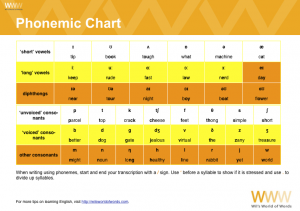 If you have been learning English, chances are you will have heard of the ‘phonemic chart’. What is it, though and why is it important?
If you have been learning English, chances are you will have heard of the ‘phonemic chart’. What is it, though and why is it important?
A phonemic chart is a guide to pronouncing all the sounds used for a certain English dialect. It uses symbols from the International Phonetic Alphabet to indicate which sounds you need to use to pronounce words in that dialect.
Phonemic charts (sometimes called ‘pronunciation charts’) are used in a lot of schools, textbooks, dictionaries and online courses nowadays. Why are they so popular, though?
1. You can use a phonemic chart to make notes on how words sound. If you have trouble pronouncing a word and your teacher corrects you on it. Write it down using symbols from the phonemic chart so you can remember how it sounds later on.
2. A lot of dictionaries use it. If you use an online dictionary, it’s easy to listen to examples of new words. If you don’t have access to a computer, though, learning to read the phonemic chart will help you find out how words should be pronounced just by looking at your dictionary.
3. If will help you become more aware. Learning the individual sounds used in English will help you become more aware of your own speech and areas you can work on to improve your pronunciation.
4. You can use it to set targets for yourself. Take a short example of someone you consider to have ideal pronunciation. Transcribe it using the phonemic chart then transcribe yourself saying the same thing. What are the differences? If you can work out the differences, you are one step towards making your pronunciation closer to how you would like it to be.
How do I learn the phonemic chart?
First of all, download the free phonemic chart from the World of Words. It comes with a worksheet to get you started. Once you have finished the worksheet. Try transcribing a short sentence every day until you are able to understand and read the symbols easily.
It doesn’t take long to learn and will really help you with your English.
NOTE: This chart is based on British RP (Recieved pronunciation).